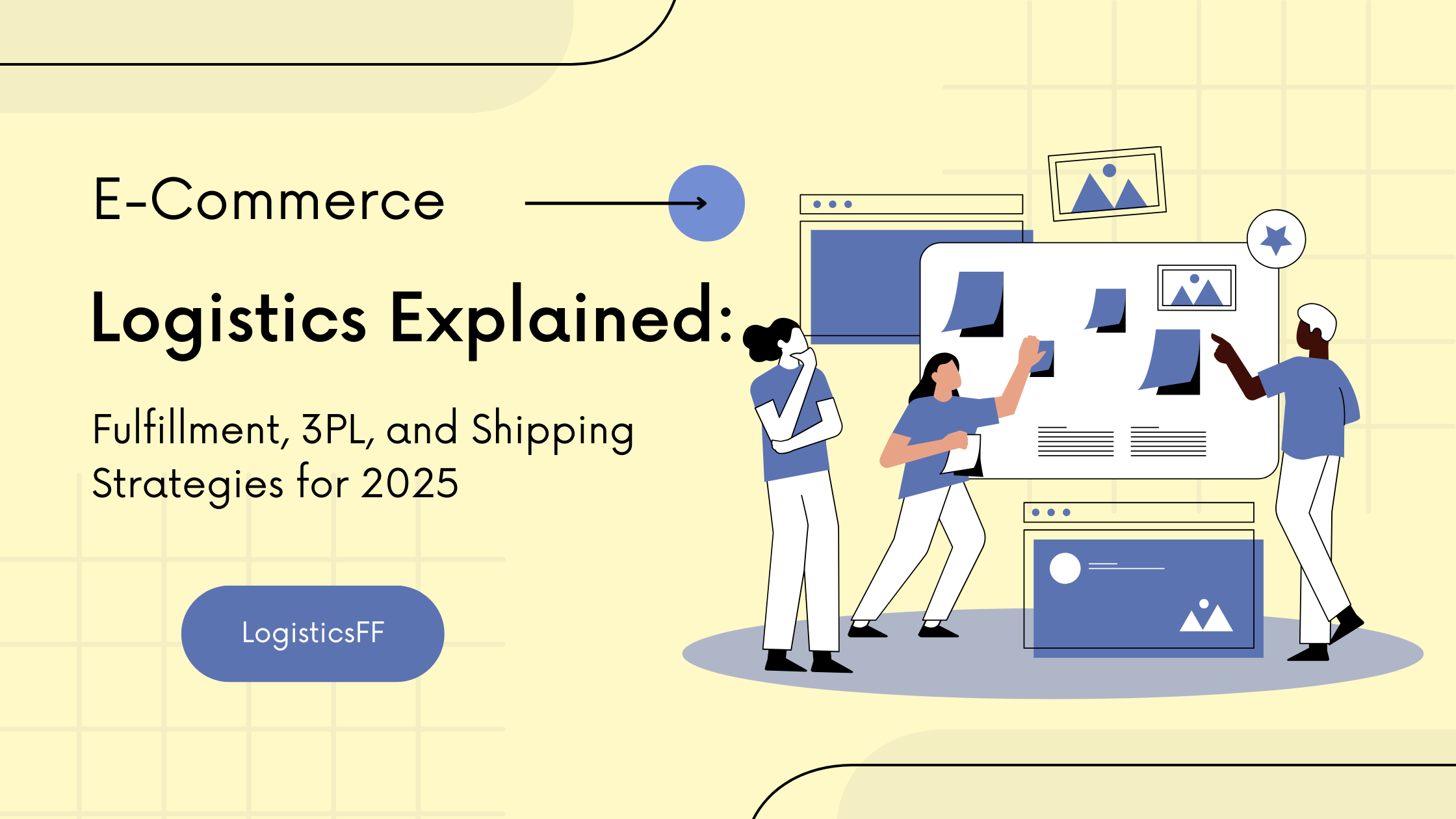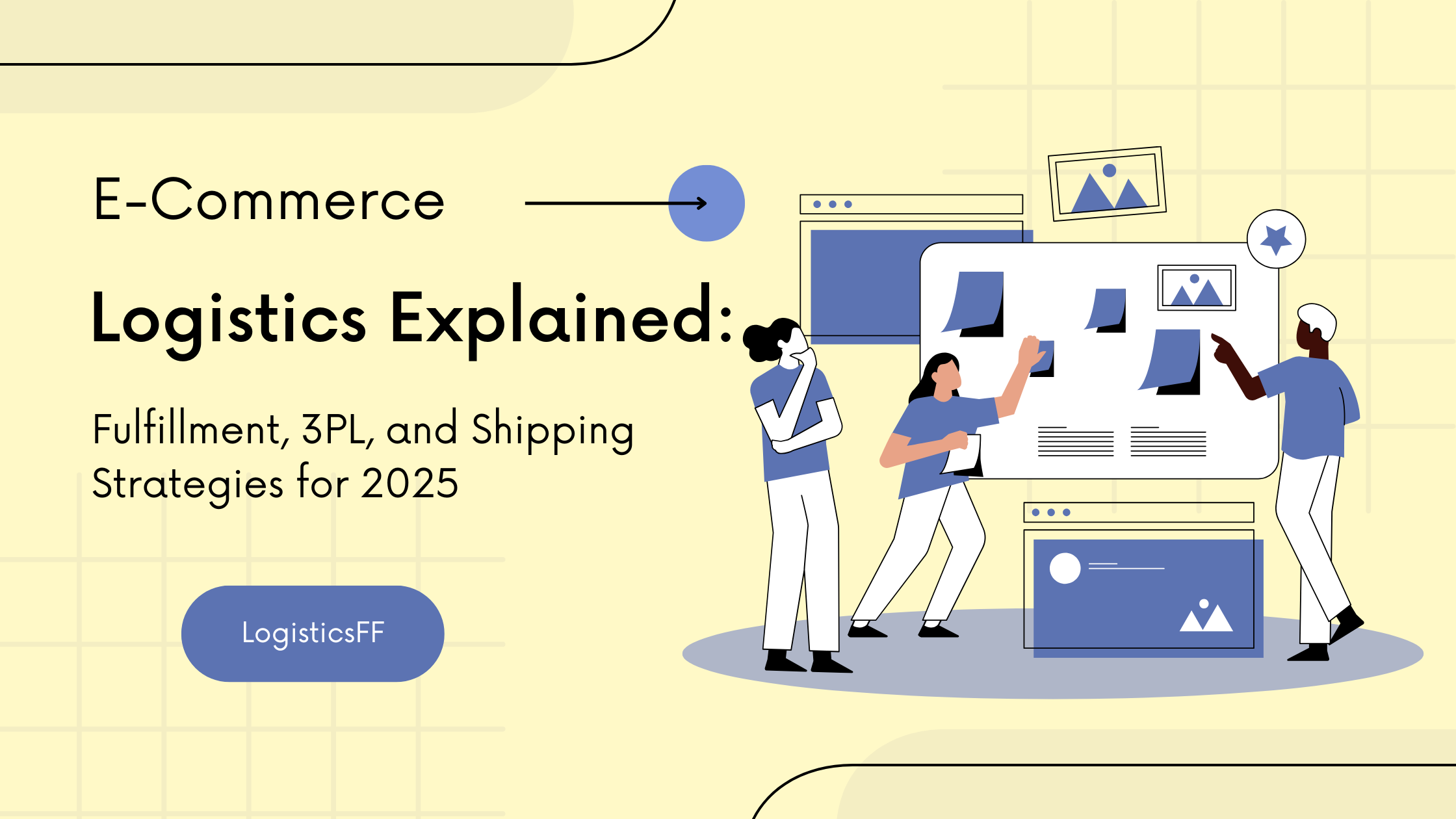In the world of e-commerce, logistics is more than just getting a product from point A to point B. It’s the foundation of customer satisfaction, brand trust, and long-term profitability. Whether you’re running a Shopify beauty store, selling gadgets through WooCommerce, or managing a dropshipping business, understanding logistics is essential for sustainable growth.
This guide will break down the key concepts, types of shipping methods, and logistics partners, helping e-commerce sellers make informed decisions as they scale.

What Is Logistics in E-Commerce?
Logistics refers to the process of storing, handling, and shipping goods to customers. For e-commerce sellers, logistics covers everything from inventory management and order fulfillment to delivery and returns.
In short, good logistics = fast, affordable, reliable delivery.
Key components include:
• Inventory storage (warehousing)
• Order fulfillment (picking, packing, labeling)
• Shipping & delivery
• Returns handling
• Customs clearance (for cross-border shipping)
Why Logistics Matters for Online Sellers
Logistics can make or break your customer experience. A beautiful product listing is useless if the delivery is late, damaged, or lost. Modern customers expect:
• Accurate tracking
• Fast shipping (under 10 days for international)
• Easy returns
• Reasonable shipping costs
A strong logistics setup ensures you deliver on these expectations while keeping margins healthy.
Types of Shipping Methods for E-Commerce
Different products and destinations require different shipping solutions. Below are the most common logistics methods used by online businesses.
1. Postal Shipping
Typically handled by government postal services (e.g., China Post, USPS, Royal Mail). It’s the cheapest option but the slowest and least trackable.
Pros:
• Low cost
• Suitable for lightweight items
Cons:
• Long delivery times (10–45 days)
• Poor tracking and customer experience
2. Express Shipping
Handled by global carriers like DHL, FedEx, or UPS. Great for urgent or premium orders.
Pros:
• Fast delivery (3–7 days)
• Reliable tracking
Cons:
• Expensive
• Volumetric pricing can be harsh for bulky goods
3. Dedicated Line Shipping
A popular hybrid for cross-border e-commerce. It combines air or rail freight from China to the destination country with local last mile couriers (e.g., USPS, Hermes).
Pros:
• Balanced speed (6–12 days)
• Lower cost than express
• Good tracking and customs clearance
Cons:
• Coverage limited to specific regions (USA, EU)
• Not ideal for very heavy items
The Role of 3PL (Third-Party Logistics) in E-Commerce
A 3PL fulfillment center is a logistics partner that stores your inventory, packs orders, and ships them directly to your customers.
Key benefits of using a 3PL:
• You don’t need your own warehouse
• Lower shipping rates via shared carrier contracts
• Focus on marketing, not shipping
• Scalable during high seasons (Black Friday, holidays)
If you’re dropshipping or scaling fast, a reliable 3PL can take your operations to the next level.
Logistics Trends for 2025 and Beyond
E-commerce logistics is evolving rapidly, driven by rising consumer expectations, automation, and sustainability demands. Understanding emerging trends helps sellers stay ahead of competitors and adapt faster to market shifts.
1. Hyper-Personalized Fulfillment
Modern consumers expect more than just fast shipping—they want options tailored to their preferences. Many 3PLs are offering personalized packaging, customized inserts, and region-based delivery lanes to improve user experience.
2. Sustainability in Logistics
With increased awareness of environmental impact, brands and 3PLs are adopting greener logistics:
• Biodegradable or recyclable mailers
• Carbon-neutral shipping options
• Route optimization to reduce fuel usage
Sellers who showcase eco-conscious practices often enjoy stronger customer loyalty.
3. DDP as the Default
Delivered Duty Paid (DDP) shipping is becoming standard. Buyers want all-inclusive pricing and expect zero surprises at customs. Modern fulfillment services now offer DDP with tax and duty management included, especially for Europe and North America.
4. Urban Fulfillment & Same-Day Delivery
Same-day and next-day delivery are no longer limited to giants like Amazon. With micro-warehousing in urban hubs and predictive inventory allocation, even mid-size e-commerce brands are offering fast delivery in major cities.
5. API-Powered Fulfillment Systems
Logistics-as-a-Service (LaaS) is enabling sellers to integrate fulfillment with minimal setup. This tech-driven model allows flexibility during campaigns, seasonal peaks, and geographic expansion.
By aligning with these trends, e-commerce sellers can improve efficiency while delivering the experience modern shoppers demand.
Understanding Supply Chain in E-Commerce
The supply chain refers to the complete journey of a product, from the manufacturer to the end customer.
Stages in a typical e-commerce supply chain:
1. Supplier sourcing (factories or wholesalers)
2. Inventory warehousing (in China or destination country)
3. Order fulfillment (when customers buy)
4. Shipping and last mile delivery
5. Returns or exchanges
A streamlined supply chain saves money, reduces errors, and improves customer reviews.
Last Mile Delivery Explained
The “last mile” is the final leg of the shipping process when the parcel travels from a local hub to the customer’s door. It’s also the most expensive and critical part of delivery.
Common carriers for last mile delivery:
• USA: USPS, UPS
• UK: Royal Mail, Hermes
• Germany: DHL Paket, Hermes
• France: Colissimo, La Poste
Smart e-commerce sellers optimize last mile by choosing regional partners and ensuring parcels are correctly labeled.
Logistics Challenges for E-Commerce Sellers
No logistics system is perfect. Here are common issues e-commerce sellers face:
• Lost or delayed shipments
• High return rates due to damage
• Inventory stockouts or overstock
• Limited tracking information
• Cross-border customs delays
Solutions:
• Use dedicated line shipping for key destinations
• Work with fulfillment centers that offer real-time tracking updates
• Forecast inventory demand with analytics
Choosing Between Domestic and Cross-Border Fulfillment
Domestic Warehousing (e.g., USA warehouse)
Pros:
• Faster delivery (2–4 days)
• Better customer experience
Cons:
• Higher inventory risk
• Costly storage fees
Cross-Border Fulfillment from China
Pros:
• Lower inventory costs
• Wide product access
• Centralized logistics
Cons:
• Slower delivery (6–12 days)
• Requires customs clearance expertise
A hybrid model—fulfilling daily orders from China but pre-stocking bestsellers in local warehouses—is increasingly popular.
Comparing Fulfillment by Region
Choosing a fulfillment strategy based on destination region can significantly improve speed, cost, and customer satisfaction.
North America (US & Canada)
• Customers expect 2–5 day delivery windows
• DDP and real-time tracking are expected
• Packaging quality and branding influence reviews
Tip: Dedicated line shipping or local warehousing are best for this region.
Europe (UK, Germany, France)
• VAT compliance and customs clearance are complex
• High demand for eco-friendly packaging and carbon neutrality
• Returns are frequent; reverse logistics must be smooth
Tip: Use fulfillment providers with IOSS compliance and localized support.
Middle East
• Cash-on-delivery (COD) remains common
• Delivery times can be slower, but tracking and communication are vital
Tip: Work with partners that reconcile COD payments and offer Arabic-language support.
Southeast Asia
• Fragmented last-mile infrastructure
• Social commerce (e.g., TikTok Live) is dominant
• Sellers need agility in inventory and fulfillment
Tip: Consider warehousing in Singapore or Malaysia for regional access.
Australia & New Zealand
• Long transit times from China (7–15 days)
• Shipping bulky items can be expensive
Tip: Use sea freight for stable SKUs and express for launches or bestsellers.
Adapting to regional logistics nuances enables sellers to balance service quality with fulfillment cost.
How to Evaluate a Logistics Provider
Whether it’s a 3PL or a shipping carrier, look at the following:
1. Shipping speed (average delivery time by country)
2. Tracking visibility
3. Pricing structure
4. Integration with Shopify, WooCommerce, etc.
5. Packaging quality
6. Returns handling
Ask for case studies or reviews from brands in your niche (e.g., fashion, skincare, tech).
Logistics Terminology Cheat Sheet
Term Meaning
3PL Third-party logistics provider
Last Mile Delivery Final shipping to the customer
DDP Delivered Duty Paid (includes customs fees)
Fulfillment Process of preparing and shipping orders
SKU Stock Keeping Unit, item identifier
Cross-Docking Directly transferring incoming to outgoing shipments
When to Switch to a Multi-Warehouse Model
A single fulfillment location may work when you’re small—but as order volume grows, so do the challenges. Here’s how to know when it’s time to scale across multiple warehouses.
Signs It’s Time
• Customers in certain regions frequently complain about shipping delays
• You’re spending too much on international express shipments
• You’re running out of inventory in specific regions
• You’re running regional promotions or influencer campaigns
Benefits of Multi-Warehouse Fulfillment
• Lower shipping costs per order due to shorter delivery distances
• Faster delivery improves conversion rates and customer satisfaction
• More flexibility during sales surges or holiday seasons
• Reduced customs complications for domestic-region orders
How to Transition
1. Analyze Sales Data by Region – Identify where demand is highest.
2. Start Small – Move 20–30% of stock into a secondary warehouse.
3. Sync Systems – Use inventory management platforms or 3PL dashboards.
4. Monitor KPIs – Track delivery times, shipping costs, and order accuracy.
Challenges to Expect
• Complexity in stock forecasting
• The risk of inventory imbalance
• Need for stronger supply chain coordination
A multi-warehouse model, when done right, can future-proof your fulfillment and provide a superior customer experience across markets.
How FF Logistics Supports Your Logistics Goals
At FF Logistics, we specialize in supporting e-commerce sellers with:
• Fast, flexible fulfillment from China
• Economic dedicated lines to USA & Europe
• Hidden “From China” shipping for brand privacy
• Cosmetics & beauty product handling
• Support for both dropshipping & bulk fulfillment
With a warehouse in Shenzhen and a team experienced in 3PL for small brands, we help reduce logistics headaches so sellers can focus on growth.

Final Thoughts
Understanding logistics for e-commerce is no longer optional—it’s essential. From managing inventory to selecting the right shipping method, logistics directly impacts your conversion rate, return rate, and customer satisfaction.
By working with the right 3PL fulfillment center and choosing smart shipping methods, you can offer a smooth and reliable experience that sets your store apart.
Copyright © 2025 FF Logistics Ltd. All rights reserved.






